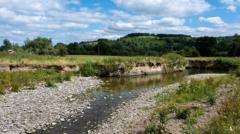Could More Hosepipe Bans Be Coming as Drought Threatens the UK?

Understanding the Current Drought Situation in the UK: Causes, Impacts, and Future Outlook
The recent declaration of drought conditions by the Environment Agency in the West and East Midlands highlights a growing concern across the United Kingdom. With Yorkshire and northwest England already in drought, hosepipe bans have been implemented for customers of Yorkshire, South East Water, and Thames Water. Other water companies are warning that similar restrictions may follow if water supplies do not improve significantly. This article delves into the various factors contributing to the current drought situation, comparisons to historical events, and potential future scenarios for the UK’s water resources.
What is Drought?
Drought is a complex phenomenon that can be understood in two primary ways:
- Meteorological Drought: This refers to a sustained period of dry weather, characterized by significantly lower than average precipitation over a defined timeframe.
- Hydrological Drought: This focuses on the lack of water resources, assessing the impact on groundwater, river flows, and reservoir levels.
In the UK, the hydrological year runs from October to September, allowing for a comprehensive analysis of water levels throughout seasons. This year, the UK has experienced one of the driest hydrological periods since 1976, with rainfall levels approximately 20% below average.
Current Drought Conditions Across the UK
As of now, various regions in the UK are experiencing drought conditions:
- West and East Midlands: Recently declared drought zones by the Environment Agency.
- Yorkshire and Northwest England: Already in drought, with existing hosepipe bans in place.
- Eastern and Southeast England: Expected to remain drier than average for the foreseeable future.
According to the latest analyses, the spring of 2025 was the second driest on record for England, contributing to the growing concern over water availability. This raises the question: what are the underlying reasons for the current drought situation?
Factors Contributing to Drought in the UK
While rainfall is often the first metric associated with drought, it’s essential to consider a multitude of factors that contribute to these conditions:
1. Climatic Changes
Climate change has led to alterations in weather patterns, resulting in hotter summers and shifting precipitation patterns. The increasing frequency of heatwaves exacerbates the risk of drought, as higher temperatures lead to increased evaporation rates from both soil and water bodies.
2. Population Growth and Urban Expansion
The UK has witnessed significant population growth and urbanization, placing additional pressure on water resources. Urban areas consume more water due to increased household demands and industrial activities, often outpacing the natural replenishment rates of groundwater and reservoirs.
3. Water Usage Patterns
Changes in water usage over time, particularly for industrial purposes and agricultural irrigation, have also contributed to the current water scarcity. Different industries require varying amounts of water, and some sectors are particularly water-intensive, leading to increased depletion of local water sources.
4. Groundwater and Reservoir Levels
Groundwater levels and reservoir capacities play a crucial role in determining water availability. The lag between rainfall and its replenishment of these sources means that even after a period of rainfall, it can take time for water levels to recover, making it challenging to manage water supplies effectively.
5. Seasonal Rainfall Patterns
While spring rainfall is critical for maintaining river and reservoir levels, autumn and winter precipitation is equally important for recharging groundwater levels. The current hydrological year has shown that, despite some improvements in rainfall in certain regions, the overall trend remains alarming.
Comparing Droughts: The 1976 Benchmark
The drought of 1976 is often considered the benchmark for drought severity in the UK. During that year, rainfall was significantly below average, culminating in severe water shortages, standpipe installations, and widespread restrictions. The circumstances of the 1976 drought are frequently compared to current conditions, but it is essential to recognize the differences:
- Rainfall Levels: From October 1975 to June 1976, the UK received only 626mm of rain, while the current year has seen slightly better levels at around 704mm.
- Duration: The 1976 drought was characterized by prolonged dry spells, but it was followed by heavy rainfall in September. Current forecasts remain uncertain, with predictions of further dry weather.
- Public Awareness: The ongoing drought has increased public awareness about water conservation, leading to earlier hosepipe bans and stronger community responses.
Impacts of the Current Drought
The multifaceted impacts of drought extend beyond simple water shortages. Various sectors are affected, including:
Agriculture
Farmers and agricultural producers are among the first to feel the effects of drought. Crop yields may decline due to insufficient irrigation, leading to potential food shortages and increased prices. Additionally, livestock may face water scarcity, impacting their health and productivity.
Ecology and Biodiversity
Drought conditions can significantly impact ecosystems and biodiversity. Reduced water levels in rivers and lakes can lead to habitat loss for aquatic species, while terrestrial wildlife may struggle to find sufficient water sources. These changes can disrupt local ecosystems and lead to long-term ecological consequences.
Public Health
Water shortages can have direct implications for public health. Lack of access to clean water for drinking, sanitation, and hygiene can lead to health crises, particularly in vulnerable populations. Furthermore, prolonged dry weather can contribute to air quality issues and heat-related illnesses.
Economic Consequences
Beyond agriculture, drought can affect various sectors of the economy. Increased water scarcity may necessitate higher costs for water procurement, impacting industries reliant on water for production. Additionally, tourism can suffer as natural attractions suffer from reduced water levels, affecting local businesses.
Future Outlook and Preparedness
The long-term forecast for drought conditions in the UK remains uncertain, with hydrologists predicting a continuation of drier than normal conditions in southern and eastern regions. However, northern and western areas may experience rainfall closer to average. Key considerations for future preparedness include:
1. Water Conservation Efforts
Public awareness campaigns and educational programs can play a vital role in promoting water conservation. Encouraging responsible usage and highlighting the importance of preserving water can help communities adapt to changing conditions.
2. Infrastructure Investment
Investing in water infrastructure, such as reservoirs and aquifer recharge systems, can improve water management and enhance resilience to drought. Upgrading existing systems to reduce leaks and increase efficiency is crucial for sustainable water use.
3. Policy and Regulation
Implementing policies that promote sustainable water management practices can help mitigate the impacts of drought. Regulatory frameworks can encourage industries to adopt water-efficient technologies and prioritize conservation efforts.
4. Research and Monitoring
Ongoing research into climate patterns, hydrology, and water usage is essential for understanding and forecasting drought conditions. Enhanced monitoring systems can provide valuable data for decision-makers, helping to implement timely restrictions and conservation measures.
Conclusion
The current drought conditions in the UK serve as a stark reminder of the complex interplay between climate, human activity, and water resources. While rainfall patterns are a significant factor, understanding the broader context of drought is critical for effective management and preparedness. As the UK navigates this challenging period, proactive measures can help secure water supplies for future generations.
FAQs
What are the main causes of drought in the UK?
The main causes include climate change, population growth, urban expansion, changes in water usage, and seasonal rainfall patterns.
How does drought impact agriculture?
Drought can lead to reduced crop yields, water shortages for livestock, and potential food scarcity, affecting prices and agricultural sustainability.
What measures can be taken to prepare for drought conditions?
Water conservation efforts, infrastructure investment, policy implementation, and ongoing research and monitoring are key measures to prepare for drought conditions.
As the UK faces ongoing challenges related to water scarcity, what steps do you believe individuals and communities can take to promote sustainable water use? #DroughtAwareness #WaterConservation #ClimateChange
Published: 2025-07-16 08:22:27 | Category: technology



